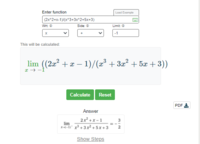Koalanet21
New member
- Joined
- Jun 16, 2020
- Messages
- 12
I used the limit calculator from allmath.com https://www.allmath.com/limit-calculator.php
I entered (2x^2+x-1)/(x^3+3x^2+5x+3) because I didn't understand how to simplify (2x-1) and (x-1). But then the algorithm gave me "3/2". I was quite surprised so I recalculated one, two, three times... no matter how many times I tried, if I do it myself, I get 0/0, not 3/2.
I really don't understand. Is the algorithm broken or am I crazy?
Here's the doubtful answer it gave me.

I entered (2x^2+x-1)/(x^3+3x^2+5x+3) because I didn't understand how to simplify (2x-1) and (x-1). But then the algorithm gave me "3/2". I was quite surprised so I recalculated one, two, three times... no matter how many times I tried, if I do it myself, I get 0/0, not 3/2.
I really don't understand. Is the algorithm broken or am I crazy?
Here's the doubtful answer it gave me.

